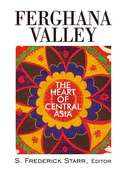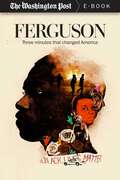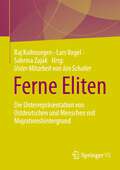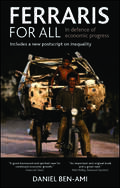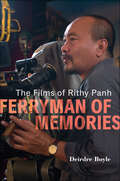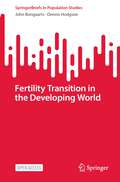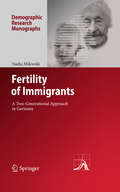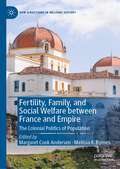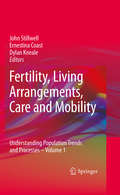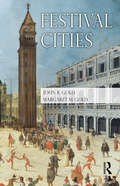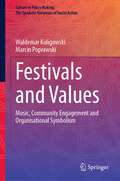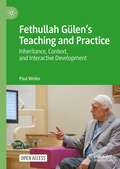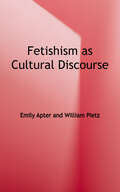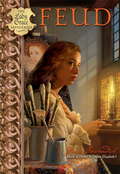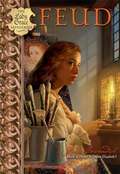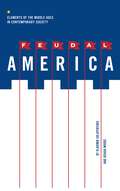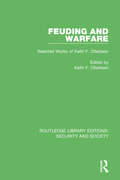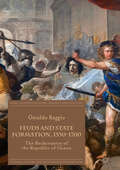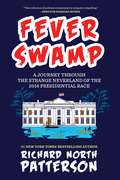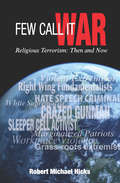- Table View
- List View
Ferdinand II, Counter-Reformation Emperor, 1578-1637
by Robert BireleyEmperor Ferdinand II (1619–37) stands out as a crucial figure in the Counter-Reformation in central Europe, a leading player in the Thirty Years War, the most important ruler in the consolidation of the Habsburg monarchy, and the emperor who reinvigorated the office after its decline under his two predecessors. This is the first biography since a long-outdated one written in German in 1978 and the first ever in English. It looks at his reign as territorial ruler of Inner Austria from 1598 until his election as emperor and especially at the influence of his mother, the formidable Archduchess Maria, in order to understand his later policies as emperor. This book focuses on the consistency of his policies, the profound influence of religion throughout his career and follows the contest at court between those who favored consolidation of the Habsburg lands and those who aimed for expansion in the empire.
Ferghana Valley: The Heart of Central Asia (Studies of Central Asia and the Caucasus)
by S. Frederick StarrThe Ferghana Valley can reasonably be said to lie in the heart of Central Asia. As such, the Valley has made an inordinate contribution to the history and culture of the region as a whole, as well as significantly affecting the economic, political and religious spheres. This book looks at the region over time, from its early history to the present. It embraces not just the obvious fields of politics, economics and religion, but also ethnography, sociology and culture, and includes the insights of leading scholars from all three Ferghana countries. The book discusses various questions of identity relating to the region, showing how the identity of the Ferghana Valley relates to the emerging national identities of the three post-colonial states that are still gradually emerging from the demise of the Soviet Union, as well as how an understanding of the Ferghana Valley is key to understanding Central Asia itself.
Ferguson: Three Minutes that Changed America
by Wesley Lowery The Washington PostFrom the Pulitzer Prize winning Washington Post comes a meticulously detailed, insightful report on the killing that brought the nation's attention to a city coming apart at the seams. 12:00PM: Officer Darren Wilson turns his Chevy Tahoe police cruiser left on Canfield Drive. 12:01PM: Wilson orders two young men, Dorian Johnson and Michael Brown, to get out of the street. 12:04PM: Michael Brown lays dying from bullet wounds. Three minutes in middle America shook a nation to its foundation. To many, it shone a spotlight on the frequently violent, often deadly interactions between young men of color and police departments. It highlighted the racial disparity in policing techniques, in response to crime, and in how race relations are perceived in an America where many incorrectly pride the country on being "post-racial." Renowned journalist Wesley Lowery has pulled together a vast and troubling panorama of reportage on the Ferguson slaying, and the aftermath--the marches, the clashes, and the slow, painful process of building trust between a devastated community and a police department tasked with serving and protecting it. Challenging and necessary, Ferguson engages America in a frank and necessary dialogue about race relations, about legacies of bigotry that continue to this day, and about a path forward as one nation, equal under the law. Contributors include: Joel Achenbach, Mark Berman, Lindsey Bever, Jeremy Borden, Amy Brittain, DeNeen L. Brown, Philip Bump, Jessica Contrera, Jahi Chikwendiu, Niraj Chokshi, Robert Costa, Alice Crites, David A. Fahrenthold, Darryl Fears, Marc Fisher, J. Freedom du Lac, Thomas Gibbons-Neff, Chico Harlan, Dana Hedgpeth, Peter Hermann, Scott Higham, Peter Holley, Sari Horwitz, Greg Jaffe, Sarah Kaplan, Kimbriell Kelly, Kimberly Kindy, Sarah Larimer, Carol D. Leonnig, Jerry Markon, Michael E. Miller, David Montgomery, Brian Murphy, David Nakamura, Abby Phillip, Steven Rich, Manuel Roig-Franzia, Robert Samuels, Sandhya Somashekhar, John Sullivan, Julie Tate, Krissah Thompson, Neely Tucker.
Ferne Eliten: Die Unterrepräsentation von Ostdeutschen und Menschen mit Migrationshintergrund
by Sabrina Zajak Lars Vogel Raj KollmorgenFern – so erscheinen vielen Menschen, insbesondere Ostdeutschen und Menschen mit Migrationshintergrund, die Eliten in der Bundesrepublik Deutschland. Die Beiträge des Bandes untersuchen aus sozialwissenschaftlicher Perspektive, ob dieser verbreitete Eindruck zutrifft und warum es ihn gibt. Die Analysen zeigen einerseits auf, in welchen Sektoren der Gesellschaft und warum Ostdeutsche und Menschen mit Migrationshintergrund unterrepräsentiert sind. Andererseits wird diskutiert, welche Folgen das für die politischen Einstellungen hat und wieso das ein gesellschaftliches Problem ist. Dafür wurden u.a. mehr als 2.800 Lebensläufe von Inhaber*innen wichtiger Führungspositionen erhoben sowie Interviews mit Elitenangehörigen und eine repräsentative Bevölkerungsbefragung durchgeführt. Den Band beschließen Handlungsempfehlungen für den weiteren gesellschaftspolitischen Umgang mit der Unterrepräsentation dieser, aber auch anderer unterprivilegierter Bevölkerungsgruppen.
Ferraris for All: In Defence of Economic Progress
by Daniel Ben-AmiThe growth of the economy and the spread of prosperity are increasingly seen as problematic rather than positive - a trend Daniel Ben-Ami has termed 'growth scepticism'. Prosperity is accused of encourage greed, damaging the environment, causing unhappiness and widening social inequalities. Ferraris for all: A defence of economic progress is a rejoinder to the growth sceptics. Using examples from a range of countries, including the US, the author argues that society as a whole benefits from greater affluence. Action is needed - but to increase abundance and spread it worldwide, not to limit prosperity, as the sceptics would have it. The lively and provocative hardback edition was published to widespread coverage in 2010, and triggered debate and dissent in equal measure.
Ferryman of Memories: The Films of Rithy Panh
by Deirdre BoyleFerryman of Memories: The Films of Rithy Panh is an unconventional book about an unconventional filmmaker. Rithy Panh survived the Cambodian genocide and found refuge in France where he discovered in film a language that allowed him to tell what happened to the two million souls who suffered hunger, overwork, disease, and death at the hands of the Khmer Rouge. His innovative cinema is made with people, not about them—even those guilty of crimes against humanity. Whether he is directing Isabelle Huppert in The Sea Wall, following laborers digging trenches, or interrogating the infamous director of S-21 prison, aesthetics and ethics inform all he does. With remarkable access to the director and his work, Deirdre Boyle introduces readers to Panh’s groundbreaking approach to perpetrator cinema and dazzling critique of colonialism, globalization, and the refugee crisis. Ferryman of Memories reveals the art of one of the masters of world cinema today, focusing on nineteen of his award-winning films, including Rice People, The Land of Wandering Souls, S-21: The Khmer Rouge Killing Machine, and The Missing Picture.
Fertile Matters: The Politics of Mexican - Origin Women's Reproduction
by Elena R. GutiérrezWhile the stereotype of the persistently pregnant Mexican-origin woman is longstanding, in the past fifteen years her reproduction has been targeted as a major social problem for the United States. Due to fear-fueled news reports and public perceptions about the changing composition of the nation's racial and ethnic makeup—the so-called Latinization of America—the reproduction of Mexican immigrant women has become a central theme in contemporary U. S. politics since the early 1990s. <P><P> In this exploration, Elena R. Gutiérrez considers these public stereotypes of Mexican American and Mexican immigrant women as "hyper-fertile baby machines" who "breed like rabbits." She draws on social constructionist perspectives to examine the historical and sociopolitical evolution of these racial ideologies, and the related beliefs that Mexican-origin families are unduly large and that Mexican American and Mexican immigrant women do not use birth control.
Fertility Transition in the Developing World (SpringerBriefs in Population Studies)
by John Bongaarts Dennis HodgsonThis open access book provides an overview and analysis of the causes and consequences of the massive and highly consequential transition in reproductive behaviour that occurred in Asia, Latin America, and Africa since the mid-20th century. In the 1950s contraceptive use was rare and women typically spend most of their reproductive years bearing and rearing children. By 2020 fertility and contraceptive use in Asia and Latin America reached levels commonly observed in the developed world. Africa’s fertility is still high, but transitions have started in all countries. This monograph is the first to provide a comprehensive analysis of these trends and their determinants, covering changes in reproductive behaviour (e.g., use of contraception and abortion), preferences (e.g., desire to limit and space births) and the role of socioeconomic development (e.g., education). The role of government policies and in particular family planning programs is discussed in depth. Particular attention is given to provide a balanced assessment of several political and scientific controversies that have beset the field. As such this book provides an interesting read for a wide audience of undergraduate and graduate students, researchers, and public health policy makers.
Fertility of Immigrants
by Nadja MilewskiThis book examines fertility patterns of post-war labor migrants and their descendants in Germany. It includes an introduction to the post-war migration history of Germany and a thorough review of the international literature on fertility of migrants and cultural sub-groups. The author uses data from the German Socio-economic Panel Study and applies event-history techniques to test a set of competing hypotheses derived from the literature. The analysis finds evidence for the effects of adaptation, socialization and composition, as well as for an interrelation of events. It does not however find evidence for a disruptive influence of migration on childbearing behavior. The book shows the advantages of a longitudinal research design over the conventional cross-sectional approach and sets a new standard for research on the fertility of international migrants and their descendants in western European receiving societies.
Fertility, Family, and Social Welfare between France and Empire: The Colonial Politics of Population (New Directions in Welfare History)
by Margaret Cook Andersen Melissa K. ByrnesThis edited volume focuses on social welfare and medicine within the French Empire and brings together important currents in both imperial history and the history of medicine. The book covers a broad period from the ‘first colonial empires’ that existed prior to 1830, the ‘new imperialism’ of the late nineteenth and early twentieth centuries, the process of decolonisation in the mid-twentieth century, and the ‘afterlives’ of colonial regimes in France and newly-independent states. Building on recent scholarship, this volume examines the extension of imperialism into the post-colonial period. The chapters examine a range of topics developing our understanding of the reasons why colonial states saw the family as a site for biopolitical intervention. The authors argue that experts built a racialised body of knowledge about colonial populations through census data and medical understandings of problems such as child mortality and infertility. They show that by analysing and compiling data on fertility, population growth (or decline), and health, this fuelled interventions designed to ensure a stable workforce, and that protecting children and mothers, vaccinating vulnerable populations, and creating modern, sanitary housing were all initiatives also aimed at serving larger goals of preserving colonial rule. Finally, the book shows that social welfare projects during the French Empire reflected concerns about race, differential fertility, and migration that continued well after decolonisation.
Fertility, Living Arrangements, Care and Mobility
by Dylan Kneale Ernestina Coast John StillwellMany parts of the world are experiencing rapid demographic restructuring, resulting in an ageing population with increasingly significant work and care pressures on cohorts less able or willing to provide support. This book examines some of the important trends that have underpinned reductions in fertility, including delayed child-bearing and increased childlessness. It demonstrates how relationships between partners have resulted in new living arrangements with changing attitudes from marriage to co-habitation as the social norm, and it considers the health and well-being for particular at risk groups such as the elderly and stepparents as well as aspects of mobility such as household migration and commuting to school. The book brings together a series of studies that all involve quantitative analyses of secondary data from censuses, surveys or administrative records. The trends and patterns reported provide new and interesting insights into behaviour of the household and the roles of adults and children, and point to questions of critical importance for practitioners and policy makers.
Festival Cities: Culture, Planning and Urban Life (Planning, History and Environment Series)
by John R. Gold Margaret M. GoldFestivals have always been part of city life, but their relationship with their host cities has continually changed. With the rise of industrialization, they were largely considered peripheral to the course of urban affairs. Now they have become central to new ways of thinking about the challenges of economic and social change, as well as repositioning cities within competitive global networks. In this timely and thought-provoking book, John and Margaret Gold provide a reflective and evidence-based historical survey of the processes and actors involved, charting the ways that regular festivals have now become embedded in urban life and city planning. Beginning with David Garrick’s rain-drenched Shakespearean Jubilee and ending with Sydney’s flamboyant Mardi Gras celebrations, it encompasses the emergence and consolidation of city festivals. After a contextual historical survey that stretches from Antiquity to the late nineteenth century, there are detailed case studies of pioneering European arts festivals in their urban context: Venice’s Biennale, the Salzburg Festival, the Cannes Film Festival and Edinburgh’s International Festival. Ensuing chapters deal with the worldwide proliferation of arts festivals after 1950 and with the ever-increasing diversifycation of carnival celebrations, particularly through the actions of groups seeking to assert their identity. The conclusion draws together the book’s key themes and sketches the future prospects for festival cities. Lavishly illustrated, and copiously researched, this book is essential reading not just for urban geographers, social historians and planners, but also for anyone interested in contemporary festival and events tourism, urban events strategy, urban regeneration regeneration, or simply building a fuller understanding of the relationship between culture, planning and the city.
Festivals and Values: Music, Community Engagement and Organisational Symbolism (Culture in Policy Making: The Symbolic Universes of Social Action)
by Waldemar Kuligowski Marcin PoprawskiThis is an original book, covering all the past areas of research anyone would need to know about festivals and ‘event-based culture’. It is based on academic research but written in a way relevant for cultural professionals – uniquely explaining the cultural power of festivals, and with original empirical research, the realities of organisation and management, and social and economic value. Dr Jonathan Vickery, Reader in Cultural Policy Studies and Director: Centre for Cultural and Media Policy Studies, Univeristy of Warwick.This book discusses music festivals in the context of the specific values they convey. Today, music festivals are a permanent feature of national, regional and local cultural policies, a valuable asset in the tourism industry and a significant source of income for an industry that has been adversely affected by the steady decline in physical sales of music. For the audience, on the other hand, it is an opportunity to escape from everyday life, multi-sensory contact with art, an activity that stands for “full-body participation”– a cultural phenomenon that drags people out of their homes like no other. There is one common denominator linking the above-mentioned features of contemporary music festivals – namely the world of values. This is evident from the non-accidental locations, festivals spaces’ design, planning and the line-ups created consciously, with great care. The organisers’ “missions”, logos, and other symbolic organisational artefacts communicate specific values. These values are explicitly mentioned by artists and audiences: they can be easily identified in online forums and media reports; participant behaviour, festival “rituals” and additional festival programs are shaped on the basis of values, and cooperation is built between the festival and the local community. As the reader will quickly realize, numbers and statistics sit alongside descriptions and quotations in this book, and the organisers’ statements are accompanied by the opinions of academics, but above all the festival audience is given a voice – both through quotations and their drawings. This voice is by no means uniform, as it turned out that research into values was often transformed into a pretext for spinning tales about one’s life situation, one’s political preferences, and one’s understanding of freedom and responsibility. Memories were mixed with declarations, joy with regret, curses with dreams, prose with poetry. Thomas Pettitt was not wrong in noting that “Social history has learnt to appreciate festival as a valuable window on society and its structures”. The authors have tried to open all the windows available. Students and researchers in the fields of cultural anthropology, social psychology, folklore studies, comparative religion, sociology of culture, cultural policy, cultural history, and cultural management will find this book highly interesting.
Fethullah Gülen’s Teaching and Practice: Inheritance, Context, and Interactive Development
by Paul WellerThis is the first book of its kind about the Turkish Muslim scholar, Fethullah Gülen, since the July 2016 events in Turkey, the trauma experienced by Gülen, and the disruption to initiatives inspired by his teaching, known as Hizmet. Drawing on primary interviews with Gülen and Hizmet participants and a literature review, this Open Access book locates the clear origins of Gülen’s teaching in the Qur’an and Sunnah in dynamic engagement with their geographical, temporal and existential reception, translation, and onward communication. It argues that as Hizmet cannot be understood apart from Gülen and his teaching, Gülen and his teaching cannot be understood apart from Hizmet, while exploring the heritage of both. A more geographically focused case study is set out in author Paul Weller’s Hizmet in Transitions: European Developments of a Turkish Muslim-Inspired Movement, also published by Palgrave Macmillan (2022).
Fetishism As Cultural Discourse
by Emily Apter William PietzFetishism is a term widely disseminated in literary and cultural studies. It carries a variety of generic meanings. Most of these derive to some degree from Marxist and psychoanalytic discourses, where the term fetishism has technical significance. This book will engage and challenge a wide audience of academic and nonacademic readers, including specialists and students in the fields of anthropology, history, literature, film, psychoanalysis, visual arts, feminist theory, Marxian criticism, and cultural studies.
Fetishism and the Theory of Value: Reassessing Marx in the 21st Century (Palgrave Studies in the History of Economic Thought)
by Desmond McNeillThis book demonstrates the continuing relevance of Marx’s critique of the capitalist system, in which value is simply equated with market price. It includes chapters specifically on the environment and financialisation, and presents Marx’s qualitative theory of value and the associated concept of fetishism in a clear and comprehensive manner. Section I demonstrates how fetishism developed in Marx’s writing from a journalistic metaphor to an analytical device central to his critique. In Section II, commodity fetishism is distinguished from other forms: of money, capital and interest-bearing capital. There follows an analysis of Marx’s complex attempt to distinguish his argument from that of Ricardo, and Samuel Bailey. The section ends with a discussion of the ontological status of value: as a social rather than a natural phenomenon. Section III considers the merits of understanding value by analogy with language, and critically assesses the merits of structural Marxism. Section IV challenges Marx’s emphasis solely on production, and considers also exchange and consumption as social relations. Section V critically assesses recent Marx-inspired literature relating to the two key crises of our time, finance and the environment, and identifies strong similarities between the key analytical questions that have been debated in each case.
Feud
by Lady Grace CavendishThere is much excitement at Court as the famous painter Levina Teerlinc arrives to paint the Queen's portrait. The Maids of Honor are recruited to help entertain the Queen during the sittings, and to pose for the painter while the Queen is busy. They love being in the studio but have to beware as deadly poisons are used in some of the paints! One of Lady Grace's fellow Maids of Honor, Carmina, begins to act rather strangely--she seems confused and always tired. Her family has recently been involved in a feud with another noble family after her father was killed in a jousting tournament--is it possible that Carmina is being poisoned? Could the painter or her assistants be involved? Can Grace solve the mystery and discover the truth behind the strange happenings at Court?From the Hardcover edition.
Feud: The Lady Grace Mysteries, Book 6
by Patricia Finney Grace CavendishThere is much excitement at Court as the famous painter Levina Teerlinc arrives to paint the Queen's portrait. The Maids of Honor are recruited to help entertain the Queen during the sittings, and to pose for the painter while the Queen is busy. They love being in the studio but have to beware as deadly poisons are used in some of the paints! One of Lady Grace's fellow Maids of Honor, Carmina, begins to act rather strangely--she seems confused and always tired. Her family has recently been involved in a feud with another noble family after her father was killed in a jousting tournament--is it possible that Carmina is being poisoned? Could the painter or her assistants be involved? Can Grace solve the mystery and discover the truth behind the strange happenings at Court?
Feudal America: Elements of the Middle Ages in Contemporary Society
by Vladimir Shlapentokh Joshua WoodsDo Americans live in a liberal capitalist society, where evenhanded competition rules the day, or a society in which big money, private security, and personal relations determine key social outcomes? Vladimir Shlapentokh and Joshua Woods argue that the answer to these questions cannot be found among the conventional models used to describe the nation. Offering a new analytical tool, the authors present a provocative explanation of the nature of contemporary society by comparing its essential characteristics to those of medieval European societies. Their feudal model emphasizes five elements: the weakness of the state and its inability to protect its territory, guarantee the security of its citizens, and enforce laws; conflicts and collusions between and within organizations that involve corruption and other forms of illegal or semilegal actions; the dominance of personal relations in political and economic life; the prevalence of an elitist ideology; and the use of private agents and organizations for the provision of safety and security. Feudal America urges readers to suspend their forward-thinking and futurist orientations, question linear notions of social and historical progression, and look for explanations of contemporary social problems in medieval European history.
Feuding and Warfare: Selected Works of Keith F. Otterbein (Routledge Library Editions: Security and Society)
by Keith F. Otterbein and R. Brian FergusonOriginally published in 1994, the late Keith F. Otterbein’s scholarship had followed an overall design since 1962, when he began conducting comparative studies of warfare using both ethnographic and cross-cultural methods. Through a conceptual framework derived from systems theory, he made signal contributions to our understanding of the role of warfare in human social evolution. He formulated a Fraternal Interest Group theory, utilizing it to explain not only feuding and warfare but also rape and capital punishment. Believing that armed combat is learned behaviour, he posed questions about its learning process that had yet to be answered. He acted as a major synthesizer of the growing literature on warfare and led attempts among anthropologists to apply their knowledge of war and peace to current events. This volume will serve both as a useful introduction to the anthropology of war and as a needed compendium of Professor Otterbein’s ideas.
Feuds and State Formation, 1550–1700: The Backcountry of the Republic of Genoa (Early Modern History: Society and Culture)
by Osvaldo RaggioThis book re-evaluates the role of local agency and provides a new perspective to the political, social and cultural history of state formation, taking a microhistorical approach and through close analysis of archival sources between 1550 to 1700. The backcountry of the Republic of Genoa is a laboratory for gauging the weight and significance of two elements which, according to Charles Tilly and other scholars, have characterized the construction of the modern state: judicial administration and fiscal extraction. The instruments employed in this respect were arbitration and compensation. Interactions between center and periphery occurred within a stratified and discontinuous fabric of fluid jurisdictions and segmented residential topographies, which constituted spaces of mediation. Such spaces were generated by conflicts between kin groups (feuds and factional alignments) and managed both by Genoese officials and by local notables and notaries, who translated a whole set of local practices into judicial procedures. This book offers a rich contextualization of material life, family relationships, economic activities, and power struggles in a corner of the Mediterranean world that was extremely important, but about which very little has been published in English.
Fever Swamp: My Journey Through The Strange Neverland Of The 2016 Presidential Race
by Richard North PattersonBy fall 2015, the rise of Donald Trump as the likely Republican nominee confirmed that, for better or worse, Americans had been transported to a strange new land populated by mysterious creatures, where the normal laws of the political universe no longer applied. Fascinated, amused, and appalled, bestselling novelist Richard North Patterson accepted an invitation to write one column per week for the Huffington Post about the presidential race. Those essays are collected here for the first time in a highly personal "journal" chronicling Patterson's observations in real time.Before long, thousands of Americans were reading Patterson's weekly descriptions of the campaign, a gauntlet without rules in which the projected psyches of the candidates reflected--and stirred--the roiling emotions of a substantially disgruntled electorate. Smart, prescient, funny, and deeply informed by extensive background research, these pieces form a narrative that captures the race as it occurred--the bald-faced lies, the painful truths, the pivotal issues, and the astonishing personalities that made the election of 2016 utterly unpredictable and uniquely consequential. Best of all, in marginalia scattered throughout the book Patterson looks back to see where he was right, where he was wrong, and where events were so beyond human experience that no one could have predicted them.In this bracing, funny book, Patterson brings to bear a novelist's piercing sensibility to the process of examining the election, moments that betray a candidate's character and inner life and hold up a mirror to the American population. Filled with fresh insights and indelible prose, Fever Swamp is a masterful take on a unique campaign filled with the pathos, humor, and important lessons of the liveliest playground shoving match.
Fevered: Why a Hotter Planet Will Hurt Our Health -- and how we can save ourselves
by Linda MarsaBeyond images of emaciated polar bears and drought-cracked lakes, there remains a major part of climate change's impact that the media has neglected: how our health will suffer from higher temperatures and extreme weather. From spiraling rates of asthma and allergies and spikes in heatstroke-related deaths to swarms of invasive insects carrying diseases like dengue or West Nile and increases in heart and lung disease and cancer, the effect of rising temperatures on human health will be far-reaching, and is more imminent than we think.In Fevered, award-winning journalist Linda Marsa blends compelling narrative with cutting-edge science to explore the changes in Earth's increasingly fragile support system and provide a blueprint—a "medical Manhattan Project"—detailing what we need to do to protect ourselves from this imminent medical meltdown. In the tradition of Rachel Carson's Silent Spring, Marsa sounds the alarm on a subject that has largely been ignored by governments and policy makers, and persuasively argues why preparedness for the health effects of climate change is the most critical issue affecting our survival in the coming century.
Few Call It War: Religious Terrorism: Then and Now
by Robert Michael Hicks&“A highly readable and well-documented account of the use and abuse of religion for violent political ends . . . This is a book well worth reading&” (Timothy J. Demy, ThD, PhD, coauthor of In the Name of God). Most Americans could not fathom how Islamic terrorists could bring down the World Trade Center or an army psychiatrist could turn on his own soldiers, taking their lives in the name of his religion. How could an ex-army veteran blow up a federal building, or a Jewish doctor gun down Muslims at worship? None of these incidents fit our conceptions of the benevolence of religion. More importantly, is there something inherent within religions that justifies the taking of human lives? In Few Call It War, Dr. Robert Hicks explores these questions and takes the blinders off illuminating the roots of religious violence, what religious terrorists have in common, and how they differ. As Hicks points out, all major religions have used violence and terrorist methodologies at some points in their histories. Few Call It War reveals how the teachings of religious founders and the sacred writings attributed to them provide rich soil from which contemporary religious clerics and ideologues gain converts. If one is interested in gaining an answer to the question, &“Of all the religions in the world, which are most prone to using violence?&” Few Call It War provides a well-reasoned answer that is well worth the read. &“A masterpiece in the study of religiously motivated terrorism. He has been fair in his critique of all religions, including movements within Judaism and even Christianity.&” —Robert L. Brennemann, PhD, professor, Intercultural Studies, North Central University
Fewer, Clearer, Higher: How the Common Core State Standards Can Change Classroom Practice
by Robert RothmanIn clear and concise language, veteran education writer Robert Rothman identifies nine instructional "shifts" encouraged by the new Common Core State Standards and provides examples of how teachers and school districts are overcoming challenges in implementation. He presents the research and rationale behind each change and provides examples of teachers making the shifts as well as sample test questions that could be used to gauge student progress in the future. Rothman also addresses major challenges that are emerging as districts and schools move to implement the standards and highlights the ways leading school districts are working to overcome them.Fewer, Clearer, Higher--the mantra adopted by the writers of the Common Core to emphasize the difference between existing state standards and the new ones needed to truly prepare all students for college or careers--is an indispensable guide for educators and anyone else seeking a better understanding of this major new development in education policy.

